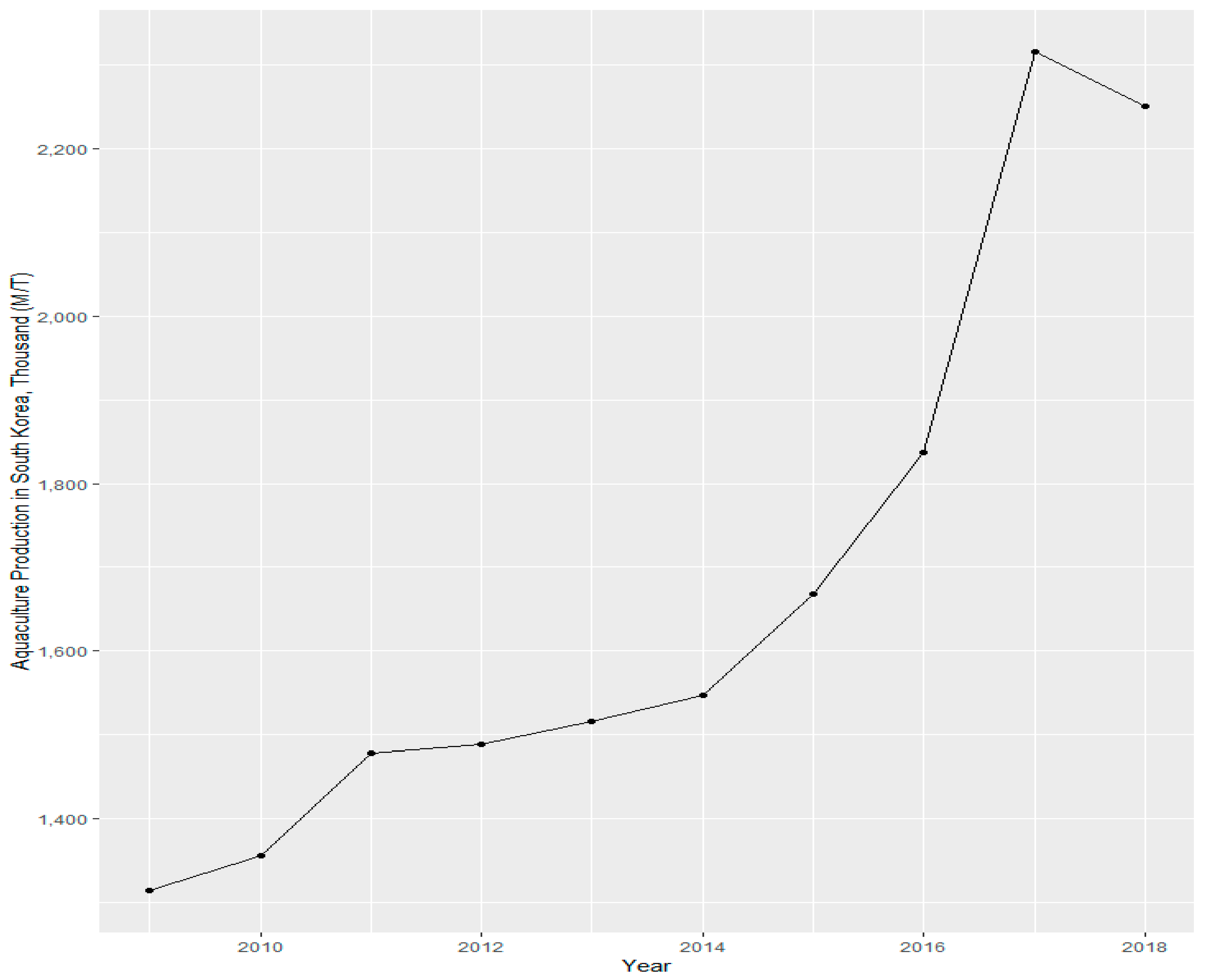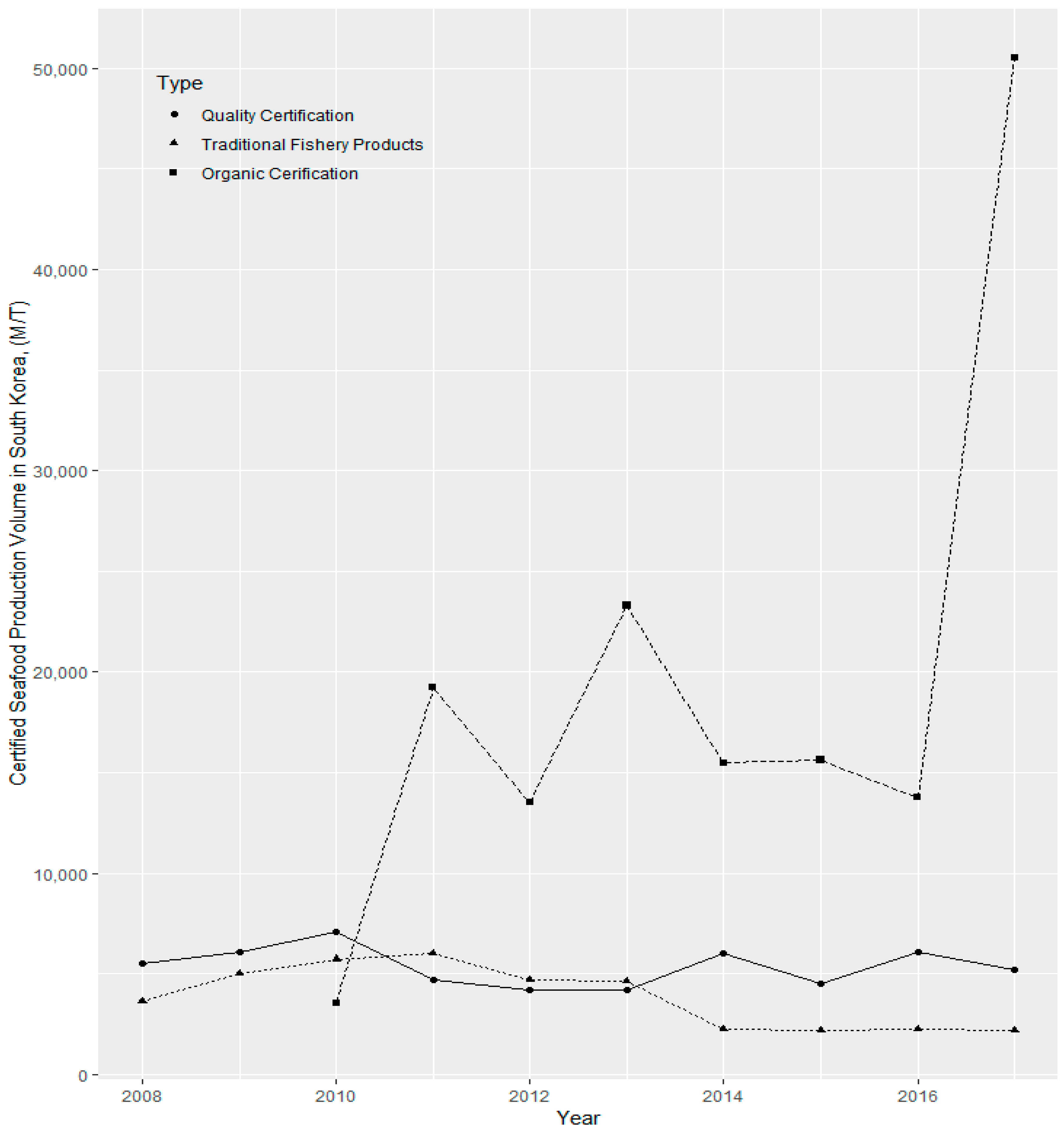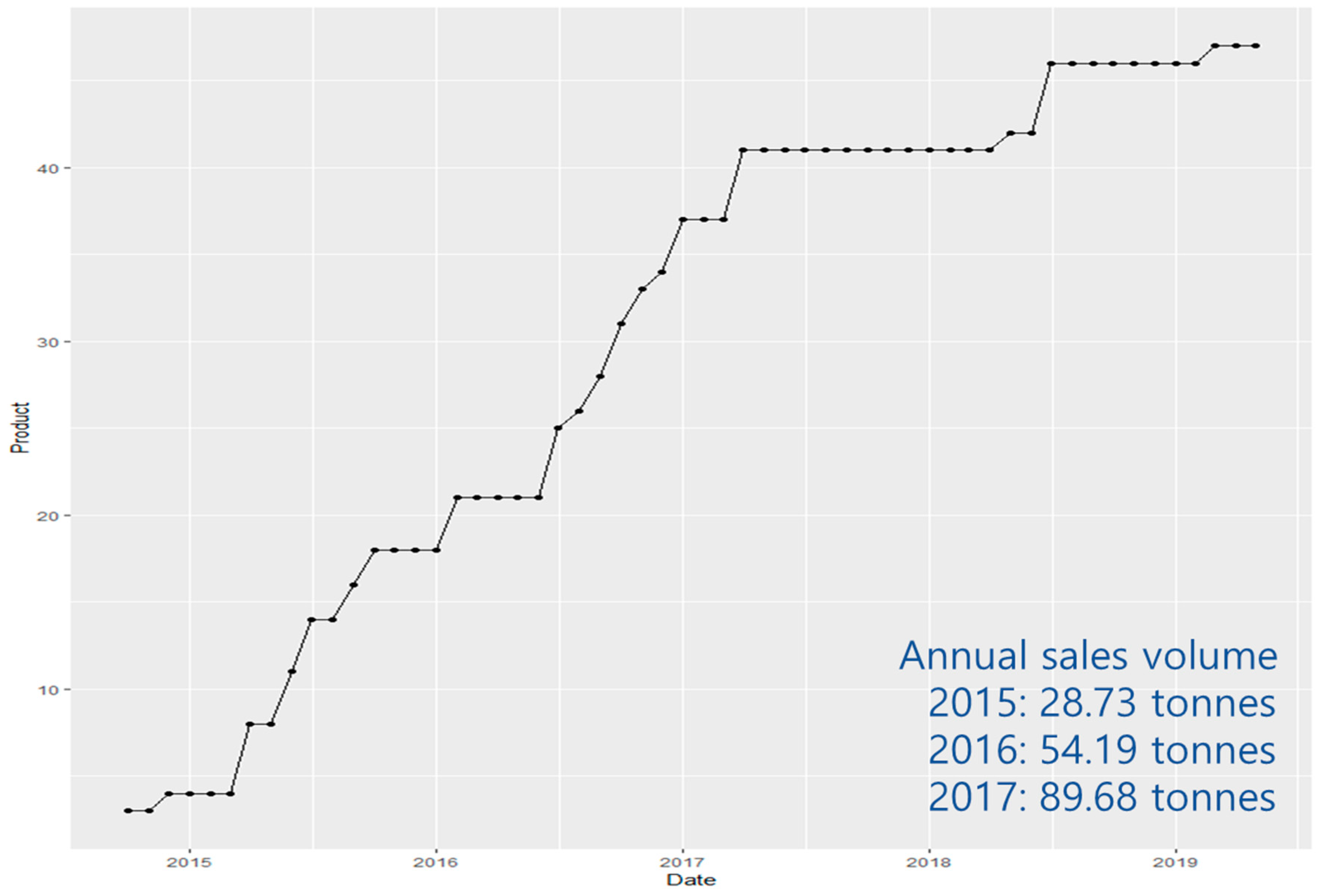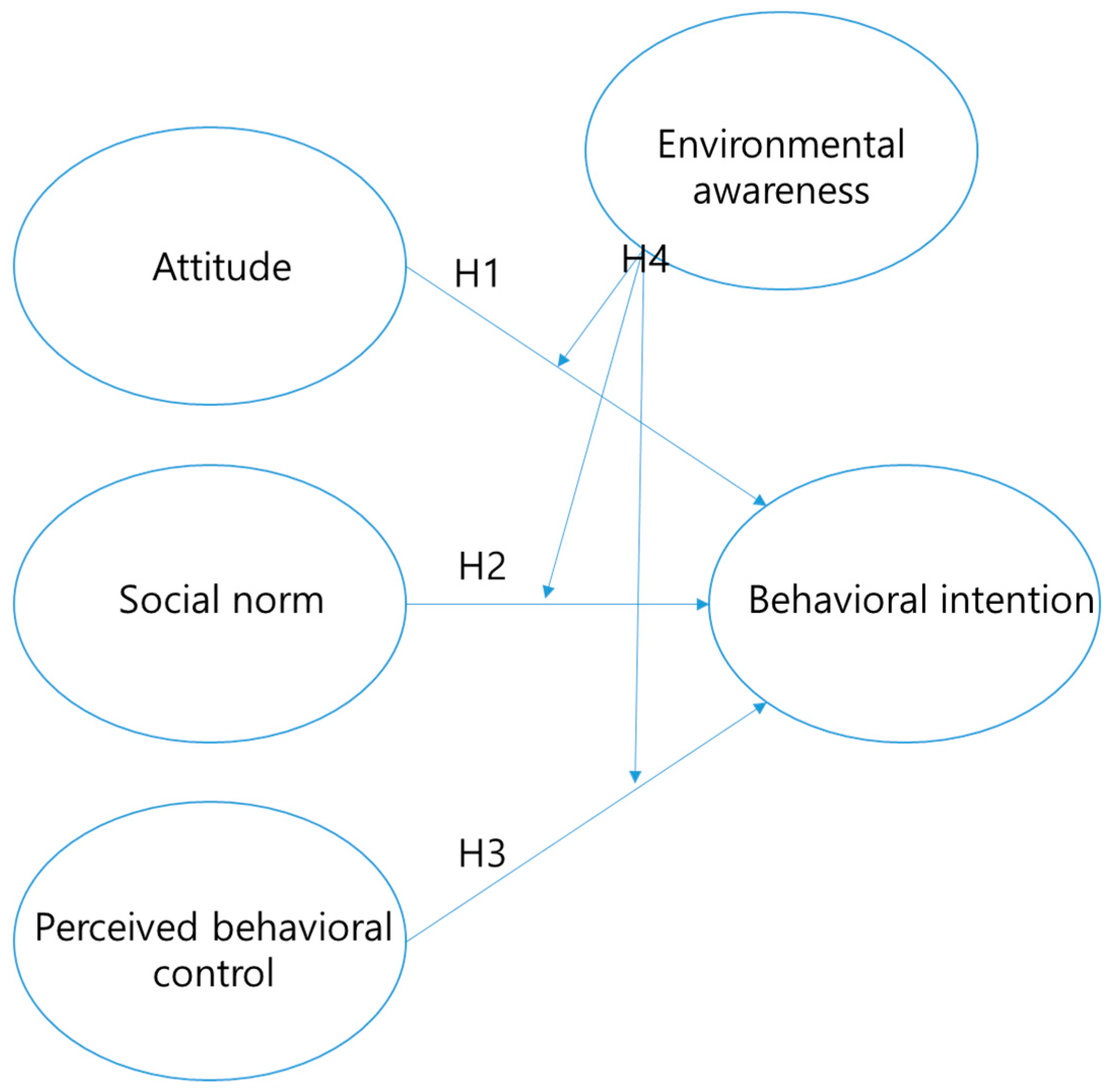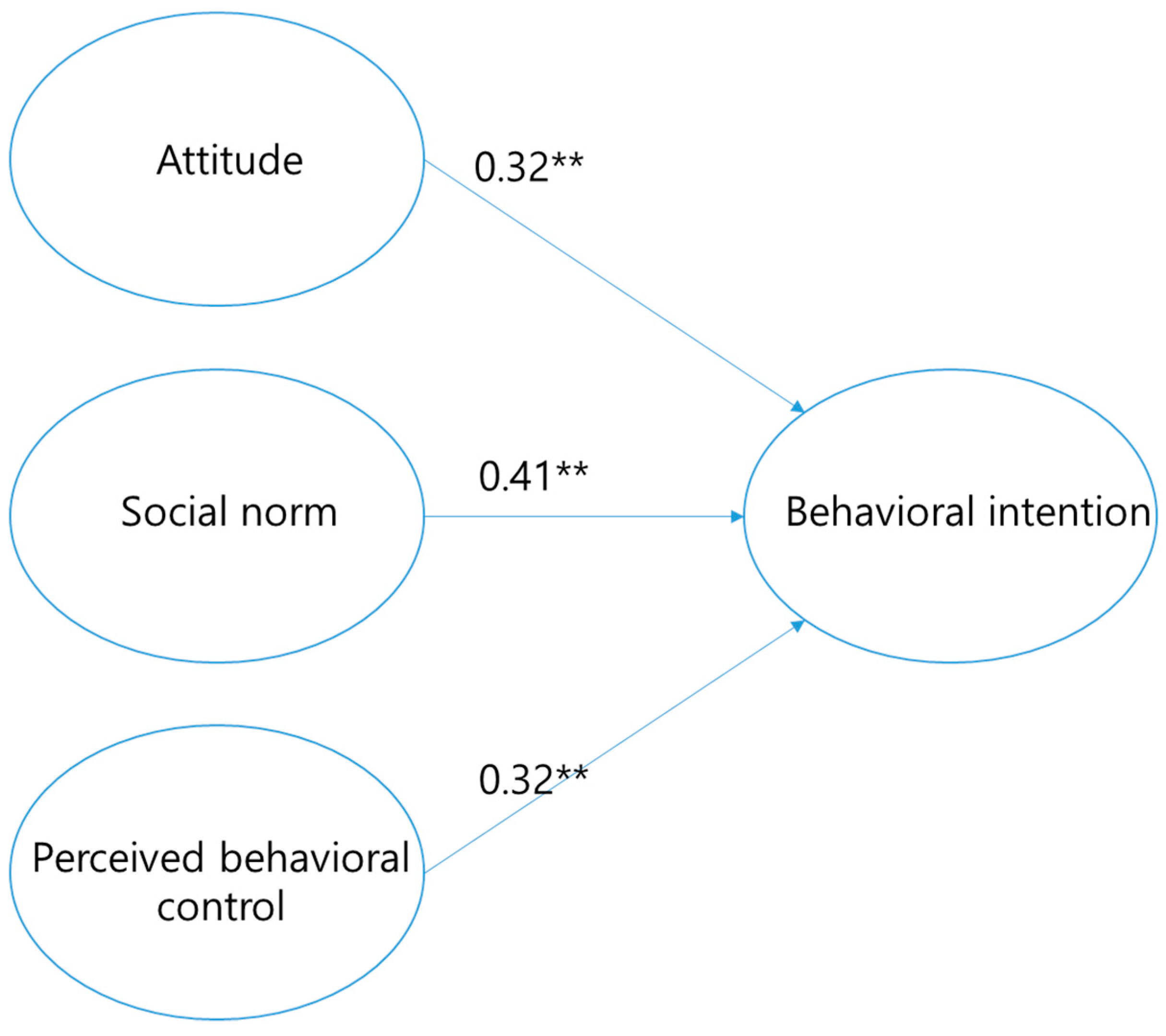1. Introduction
The Food and Agriculture Organization (FAO) developed new guidelines on sustainable aquaculture certification in 2011 following a dramatic increase of global aquaculture production [
1]. Based on the guideline, many sustainable aquaculture certification systems were launched, establishing an international sustainable aquaculture standard [
2,
3,
4]. In particular, the Aquaculture Stewardship Council (ASC) certification is one of the major sustainable aquaculture certification systems. It has grown rapidly in Europe, and recently expanded into North America and Asia [
5].
The Korean government is making efforts to transform conventional aquaculture into sustainable aquaculture by creating relevant laws and implementing certification systems [
6]. The law “Act on the Promotion of Environment-friendly Agriculture and Fisheries and the Management of and Support for Organic Food (Korea)” required a promotion plan every five years to facilitate the transition to sustainable aquaculture, and has a legal basis for the certification of organic foods. The Korean aquaculture industry produced 2.25 million tonnes of aquaculture products in 2018 (
Figure A1), increasing the share of certified products in total production (
Figure A2). To be specific, the volume of certified organic production increased from 13,757 tonnes in 2016 to 50,540 tonnes in 2017, an increase of 267%. This trend shows that the Korean domestic market has great potential for supporting sustainable aquaculture.
Academia has responded to the market trend with various types of research on sustainable aquaculture. The FAO certification guidelines provide a basic direction for implementing sustainable aquaculture and Sustainable Development Goals (SDGs), but details on how to transition to a sustainable aquaculture industry should be driven by further research [
7,
8]. For example, consumer support for sustainable aquaculture is essential in a market-based approach, therefore, consumer research on sustainable aquaculture products is of great importance [
3]. Consumer support can be earned through implementing sustainability-related certification systems [
9]. The certification systems are a mechanism for transferring value, trust, and reward between producers and consumers.
Even though consumer awareness of and support for sustainable aquaculture are an essential factor for implementing sustainable aquaculture, academic research on consumer awareness and attitudes toward sustainable aquaculture have been limited. It is unclear which latent variables affect pro-environmental consumer behavior (e.g., purchasing certified products for sustainable production) and how the environmental awareness of the consumer affects their behavior. Therefore, the author proposes the following research questions so as to fill such research gaps:
What are the relationships between underlying latent variables determining pro-environmental behavior, such as purchasing certified products?
Does environmental awareness affect consumers’ decision-making process?
The purpose of this study is to analyze the determinants of consumers’ pro-environmental behavior using ASC-certified products as an example. Specifically, the author examines how the consumers’ perception affects their decision-making process through the framework of the theory of planned behavior (TPB), which is a dominant consumer behavior analysis tool.
5. Discussion and Implication
The present study attempted to explore how consumer attitudes and the perception of sustainable aquaculture affect behavioral intention to purchase certified products using ASC-labeled seafood as an example. This study also investigated how consumers’ environmental awareness affects their decision-making about purchasing sustainable aquaculture products. In particular, the present study utilized the TPB model to examine the inter-relationships among the critical constructs in terms of pro-environmental behavior modeling.
The results of SEM revealed that consumer attitude, subjective norm, and perceived behavioral control are significant factors that affect behavioral intention to purchase ASC-labeled products. Such results are consistent with previous studies on food selection [
45,
46,
47,
48,
49]. However, the results of the TPB model show that all three constructs have significant effects, but subjective norm has the most substantial effect on behavioral intention (
Figure 3). These results are consistent with the findings of Wang et al. [
27]. However, they contradict some studies [
29,
47,
49,
50], which found that the subjective norm is the least influential construct of the TPB model, emphasizing the importance of attitude. This difference could be due to the employment of a different research sample, which comes from a non-identical social and cultural backgrounds. Specifically, the current study is based on samples from a developed country that has a secure social system, where the social norm functions well.
The uniqueness of this study lies in its use of environmental awareness as a moderator in the TPB model for the purchase of sustainable aquaculture products. This approach is similar to Wang et al. [
51], in that they utilized environmental interpretations as a moderating variable for explaining tourists’ pro-environmental behavior. The present study showed that environmental awareness moderates the relationship between attitude and behavioral intention. In the high awareness group, attitude influences behavioral intention more than social norm does. On the contrary, in the low awareness group, social norm influences behavioral intention more than attitude does. This finding implied that the high awareness group would actively participate in pro-environmental behavior, and that attitude plays a vital role in determining these consumers’ behavior. The low awareness group would less actively participate in pro-environmental behavior; the low awareness may well respond to social norm (i.e., social pressure and external factor) rather than attitude (internal factor).
The research findings have crucial implications for the aquaculture industry and seafood marketing. The South Korean government has been making efforts to change the aquaculture production system in order to convert to sustainable aquaculture. Since 2014, the Korean government has established a support plan and policies for the transition to sustainable aquaculture, including an eco-friendly equipment supply program, an eco-friendly aquaculture feed program, and fish farming site relocation [
6]. However, the government-led programs have some limitations because they depend on the government budget and planning.
In addition, the Korean government has attempted to provide information about sustainable aquaculture products to help drive change in the Korean aquaculture industry. The government has established a certification system, providing information about how seafood is produced. However, its scope remains at the minimum level of organic certification, which satisfies consumers’ desire to consume safe seafood. However, recent changes in the aquaculture industry have exceeded this level. For example, the standards of the ASC certification system call for a comprehensive level of sustainability ranging from species protection to child labor bans. In this case, the government-led transition to sustainable aquaculture is inherently limited. Government policies that take into account the acceptability of fishers have a limited ability to follow rapid changes in market-driven demand. The limited budgets and capacity of government are not sufficient to drive the conversion to sustainable aquaculture. One hopeful fact is that in the case of consumer-driven certification systems, such as ASC, a virtuous cycle of expansion is in operation, and it is gaining momentum. For example, the ASC has been growing in capacity, budget, and publicity. The ASC’s Asia-Pacific region has recently been split into two divisions, one for Asia and one for the Pacific. The budget and capacity of each regional headquarters has been expanded as well. This tendency means that a consumer-led certification system is emerging and the transition to sustainable aquaculture, which is dependent on government efforts, is becoming stronger through consumer participation. However, despite these changes in the market, there is a lack of scientific evidence on how consumer participation is supporting such a transition.
In this study, the author identified that the TPB model can verify how consumers’ attitudes toward sustainable aquaculture, social pressures, and perceived behavioral control affect purchasing decisions for sustainable aquatic products. This could be a novel contribution of the present research to the literature. In addition, the results of the study should be useful for marketing practitioners. Consumers’ support for sustainable aquaculture is based on individuals’ attitudes and social norms. Specifically, the social pressure factor is stronger than other personal factors. The next influential factors are attitude and perceived behavioral control of sustainable aquaculture. In other words, social consensus and norms are essential for the transition to sustainable aquaculture through consumer participation. An individual’s participation is determined by his or her attitude toward the activity and the social judgment value perceived by society.
Consumers’ strong support for sustainable aquaculture could lead to a boycotting of unsustainable aquaculture products. This tendency is illustrated by the “Take a Pass on Chilean Sea Bass” campaign in 2002 [
52,
53]. The present study’s results show that consumers with high environmental awareness are more willing to support sustainable aquaculture actively. Environmental and consumer groups are leading the movement to purchase sustainable aquaculture products, thereby raising consumer awareness. Considering this trend, sustainable aquaculture is likely to become more widespread.
If the paradigm of past aquaculture was to produce seafood at lower cost, the paradigm of future aquaculture is to produce seafood sustainably considering social, economic, and environmental factors. Purchasing sustainable aquaculture is one method to implement sustainable aquaculture. In the past, the production of aquaculture products in a sustainable manner was difficult, owing to high-cost problems. However, recent consumer participation is changing this situation, thereby alleviating the cost problem.
Sustainable aquaculture certification (e.g., ASC) facilitates consumer participation in aquaculture, serving as the basis for the transition to sustainable aquaculture. However, the Korean government needs to provide policy support for this transition. Currently, the ASC is using its chain of custody (COC) certification system to support the distribution of certified seafood. Such private certification schemes are excellent in terms of effectiveness. However, they are relatively costly, and are a burden to producers and consumers in the long run. One government policy option is to improve the traceability of aquaculture production, processing, and distribution. A well-established public system could be an answer to the cost issue.
The present study has the following limitations. The current research investigated consumers’ intention to purchase ASC-certified products using the TPB model. Although the ASC certification is the most successful and well known, it is difficult to generalize the research findings to the entire aquaculture industry based on an analysis of one certification system and one country (i.e., South Korea). Therefore, the research findings may only apply to the Korean domestic market; additional research is required to confirm whether the findings would be applicable in other cultures and countries using other certification systems.
